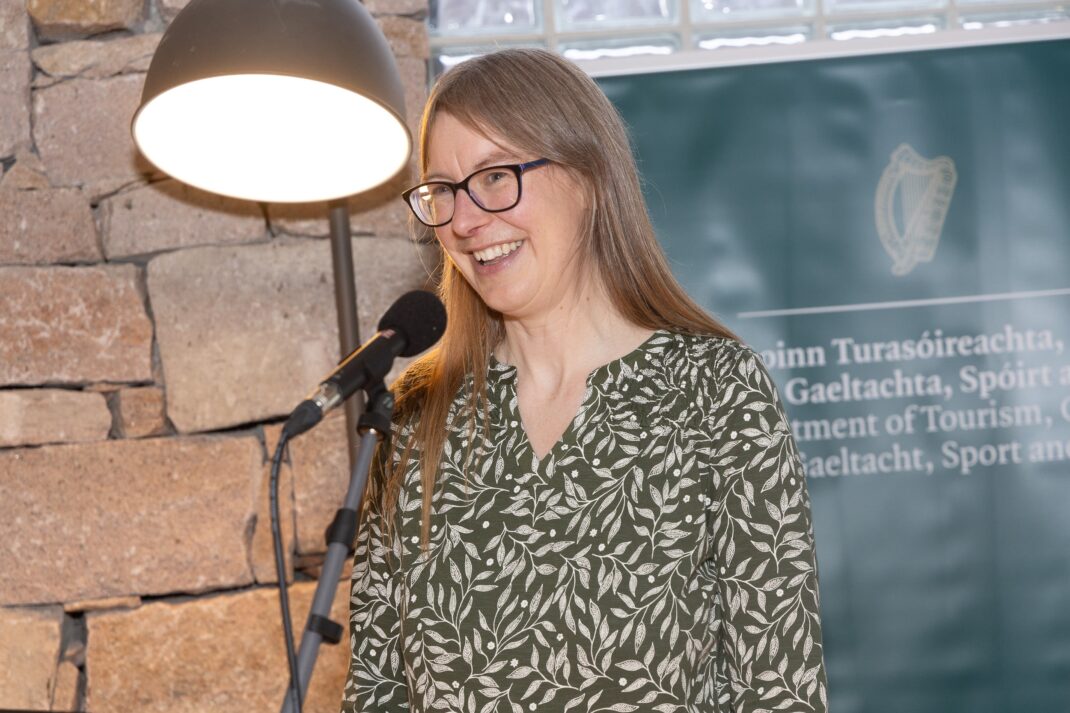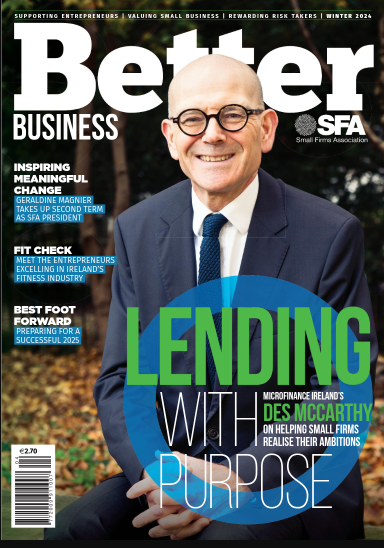Ealaín na Gaeltachta supports the arts and artists in Irish language areas across the country. Its new CEO, Rachel Holstead, speaks to Deanna O’Connor about the new role and how she’s set to make a difference.
Ireland’s Gaeltacht areas are the strongholds of our native language, traditional music and culture. Protecting and nurturing the economic, social and cultural development of the Gaeltacht areas has been the responsibility of Údarás na Gaeltachta since 1980 and in 1997, Ealaín na Gaeltachta was founded as a partnership with The Arts Council, with a mission to develop both contemporary and traditional arts in the Gaeltacht. Its remit covers the development and support of arts across all the Gaeltacht – Donegal, Mayo, Galway, Kerry, Cork, Meath and Waterford, encompassing six inhabited islands. With a population of under 100,000 in Gaeltacht areas recorded in the 2016 census, the organisation is presented with a unique set of challenges with such a wide geographical distribution, serviced by only a few official arts centres.
The Ealaín na Gaeltachta team clock a lot of miles, covering their territories, but tend to come together in Galway as a meeting point. It’s a small organisation – with just nine staff currently, and a new part-time communications position recruiting, which will bring it up to 10. Rachel Holstead has been with Ealaín na Gaeltachta since 2017 and in June of this year took up the role of chief executive. Before that, she was proud to be called an ‘áisitheoir’ – a facilitator – with the organisation.
Holstead points out that the job description ‘áisitheoir’ has much more pleasant connotations than ‘oifigeach’ or officer, and is more indicative of how the organisation operates – facilitating and supporting. “Our job is to make people’s lives easier, not to officiate over them or to be in charge of them.” Their ethos is very much “How can we help? How can we support?” The services and grant schemes provided by Ealaíon na Gaeltachta support both arts organisations – festivals, projects and venues – and individual artists.
Holstead was born in the Corca Dhuibhne Gaeltacht, to English parents. Her father is an artist, her mother a piano teacher. They didn’t have Irish at home but as young children do, they picked it up quickly when surrounded by the language at school. “When my sister and I were little, it was our secret language. When we went to primary school here, we were pretty much the only kids who didn’t know Irish, but we just soaked it in, as you do at that age.”
Growing up, her ears were filled with the sounds of both classical music at home and the traditional music of the area, attending weekly classes given by artists who came out from Siamsa Tíre in Tralee. Holstead began her career as a composer, after studying music firstly at Trinity College Dublin, before completing a PhD in composition at Queen’s University Belfast. She has written for the Irish Baroque Orchestra, Irish Chamber Orchestra and Ulster Orchestra, and was commissioned by RTÉ to compose a short string quartet for Seamus Heaney’s 70th birthday celebrations.
Reflecting back on that time of her life now she says, “I feel really lucky that it is something I can draw on… It does feel really luxurious to have had the opportunity to do that.” The support of Ealaín na Gaeltachta was crucial to getting her early career as a composer off the ground, benefitting from funding which allowed her to work on composition. She has seen from the other side; how valuable it is to support artists and give them the opportunity to create. She fondly recalls being given a little room in An Díseart, an old convent-come-unofficial-arts-centre In Dingle town, to use as a studio while she worked on a piece to commemorate 50 years since the evacuation of the Blasket Islands. “I really appreciate what that kind of support can give you creatively. The difference it makes to have the time to be able to take up an opportunity like that and work with really good people.”
She later spent 10 years on the board of the National Concert Hall and was then appointed as a music advisor to the Arts Council – a consultancy role assessing funding applications which was her first time looking at arts funding from the other side. “I tried to hold on to the experience of being the artist,” she says, “What’s it’s like to experience those systems and support, or lack of support all the times you apply and don’t get it.”
She describes it as a very privileged position: “You’re getting to see not just what people are doing, but what they want to do. You’re getting to see all of their dreams.” She first joined Ealaín na Gaeltachta covering maternity leave in Donegal, but when a position came up closer to home, she jumped at the chance to base herself back in Corca Dhuibhne, covering the Munster beat. The broad area stretches from the Dingle Peninsula in Kerry over as far as An Rinn in Waterford and takes in Gaeltacht areas in Cork, including Oileán Chléire (Cape Clear Island).
“As part of the government’s plan for the Irish language, each Gaeltacht area has developed their own language plan and when that plan has been developed by the community, the government gives them funding for an Irish language officer to help implement the plan,” she explains. An example of where Ealaín na Gaeltachta’s work has been symbiotic with this is on Oileán Chléire where in a beautifully full circle moment, an artist who had come the island on a residency ended up setting up a residency programme and eventually getting the job of Irish language officer for the island. “A lot of what he’s doing in that role, he is doing through the arts. The arts are really central to how the language is being supported in the community on the island.”
A new festival and arts events have attracted not only visitors but other artists to live on the island. This example of the ability of the arts to draw a crowd is important not just for tourism but also social cohesion and repopulating dwindling communities, and of course, keeping the language alive. Her own family history being a case in point – an artist and his family moving to a Gaeltacht area and the children becoming Gaelgeóirí. It’s a pattern that she hopes will replicate in the case of the Ivereagh Peninsula in Co Kerry.
She recalls a number of years ago, “A crisis was identified, where the population had plummeted and with it the number of Irish speakers.” An inter-departmental government task force set about addressing how to reverse that and Ealaín na Gaeltachta was invited to contribute. It guided them to prioritise any opportunities they could support in the area. “What is already happening is artists are moving to the area,” she says, including young couples. “More people are looking to spend time in the area. There’s a greater level of concert events, activities, festivals.”
How communities can get to have art as part of their everyday lives is a question she ponders on, aiming to make the arts accessible. She is delighted to see Ealaín na Gaeltachta’s new youth programmes in traditional arts and theatre come to fruition, the results of direct partnership with the Department of Tourism, Culture, Arts, Gaeltacht, Sport and the Media. “It’s absolutely brilliant because it’s an area of work we wanted to grow for a long time, and we just hadn’t had funding for it.” The programmes have boosted not only the budgets but also the size of the team, after 20-odd years running on a team of three aisitheoir and a bainisteoir.
Having been part of developing the current strategy, coming into her new role this year, Holstead is continuing the work in progress, and “trying to make sure the systems are supporting the team as well as they could” as well as developing how they invite and incorporate feedback. “There’s a constant cycle of review, adjust, see what happens.”
Now in year two of the five-year strategy, her goal is that “By the time we’re writing our next strategy, we can be confident in the goals we’re setting out, that they really reflect the needs across our sector and that we can be really ambitious in those goals.”




